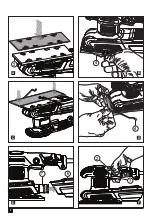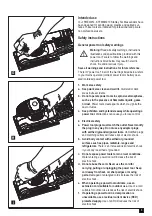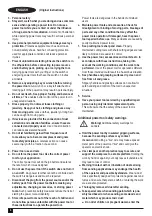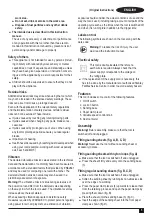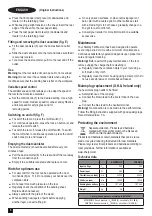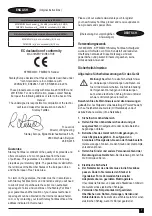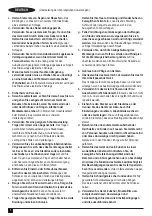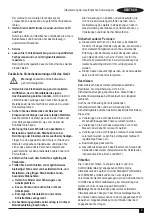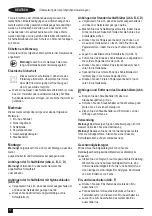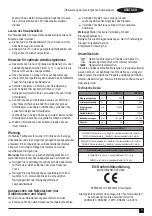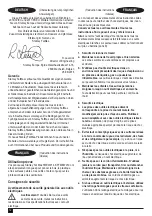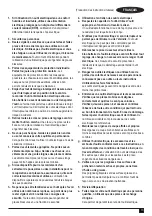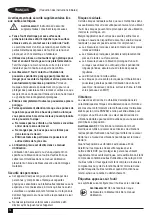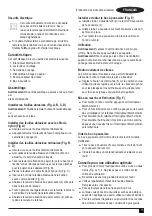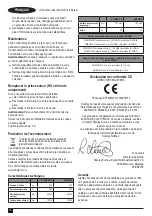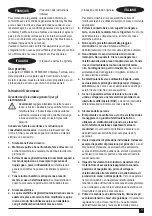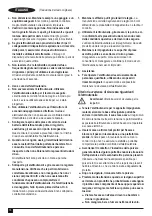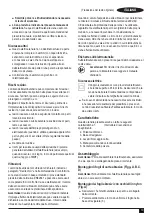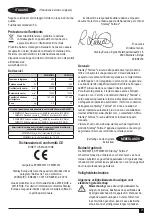
6
ENGLISH
(Original instructions)
u
Press the front paper clamp lever (4) downwards and
locate it in the retaining groove.
u
While keeping a slight tension on the sheet, insert the rear
edge of the sheet into the rear paper clamp.
u
Press the rear paper clamp lever (4) downwards and
locate it in the retaining groove.
Fitting and removing the dust cannister (fig. E)
u
Fit the dust cannister (6) over the dust extraction outlet
(7).
u
Slide the dust cannister onto the tool and make sure that it
is securely located.
u
To remove the dust cannister, pull it to the rear and off the
outlet.
Use
Warning!
Let the tool work at its own pace. Do not overload.
Warning!
Do not cover the ventilation slots when using the
tool. Make sure that the sanding base is flat on the workpiece.
Variable speed control
The variable speed control allows you to adapt the speed of
the tool to the workpiece material.
u
Set the control knob (5) to the desired setting. Use a high
speed for wood, medium speed for veneer and synthetics
and low speed for acrylic glass and for
removing paints
Switching on and off (fig. F)
u
To switch the tool on, press the on/off switch (1).
u
For continuous operation, press the lock-on button (2) and
release the on/off switch.
u
To switch the tool off, release the on/off switch. To switch
the tool off when in continuous operation, press the on/off
switch once more and release it.
Emptying the dust cannister
The dust cannister (2) should be emptied after every ten
minutes of use.
u
Pull the dust cannister (6) to the rear and off the tool away
from the connection port.
u
Empty into a suitable receptacle and replace on tool.
Hints for optimum use
u
For user comfort, the tool can be operated with one or
two hands (fig. G, H, I). Do not place your hands over the
ventilation slots.
u
Do not exert too much pressure on the tool.
u
Regularly check the condition of the sanding sheet.
Replace when necessary.
u
Always sand with the grain of the wood.
u
When sanding new layers of paint before applying
another layer, use extra fine grit.
u
On very uneven surfaces, or when removing layers of
paint, start with a coarse grit. On other surfaces, start
with a medium grit. In both cases, gradually change to a
fine grit for a smooth finish.
u
Consult your retailer for more information on available
accessories.
Maintenance
Your Stanley Fat Max tool has been designed to operate
over a long period of time with a minimum of maintenance.
Continuous satisfactory operation depends upon proper tool
care and regular cleaning.
Warning!
Before performing any maintenance on the tool,
remove unplug the charger before cleaning it.
u
Regularly clean the ventilation slots in your tool using a
soft brush or dry cloth.
u
Regularly clean the motor housing using a damp cloth. Do
not use any abrasive or solvent-based cleaner.
Mains plug replacement (U.K. & Ireland only)
If a new mains plug needs to be fitted:
u
Safely dispose of the old plug.
u
Connect the brown lead to the live terminal in the new
plug.
u
Connect the blue lead to the neutral terminal.
Warning!
No connection is to be made to the earth terminal.
Follow the fitting instructions supplied with good quality plugs.
Recommended fuse: 5 A.
Protecting the environment
Z
Separate collection. Products and batteries
marked with this symbol must not be disposed
of with normal household waste.
Products and batteries contain materials that can be recov-
ered or recycled reducing the demand for raw materials.
Please recycle electrical products and batteries according to
local provisions. Further information is available at
www.2helpU.com
Technical data
KFFMEW210
FMEW214
Input voltage
V
AC
230
230
Power input
W
280
280
Oscillations (no load)
min
-1
24000
24000
Orbits (no load)
min
-1
12000
12000
Sanding base surface
mm
187 x 90
187 x 90
Weight
kg
2.0
2.0
Level of sound pressure according to EN 62841:
KFFMEW210 Sound pressure (L
pA
) 85 dB(A), uncertainty (K) 3 dB(A)
FMEW214 Sound pressure (L
pA
) 85 dB(A), uncertainty (K) 3 dB(A)


